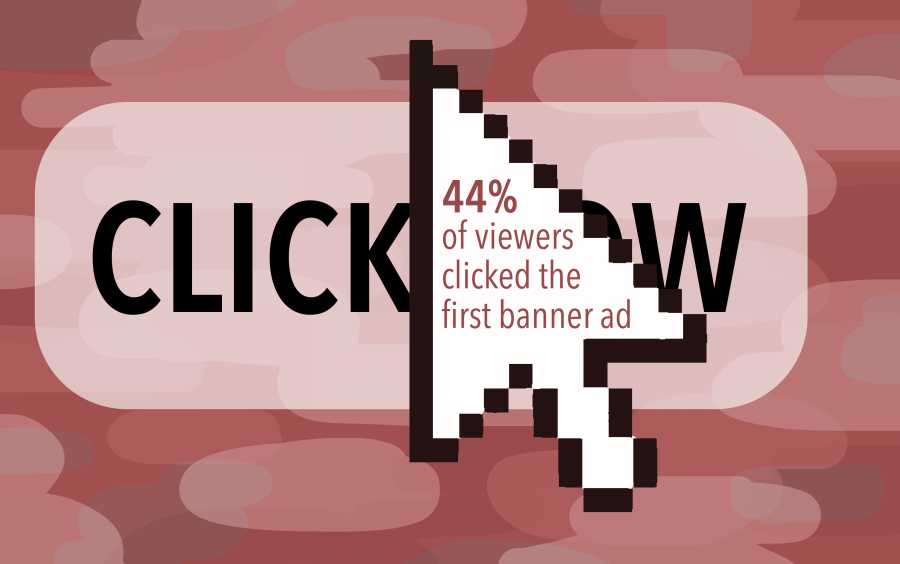Online ads lose tractions as customers refuse to click
October 11, 2016
A video of crispy grilled shrimp falling gracefully onto a plate in slow motion before a math tutorial. A portal to a virtual world of celebrity chat rooms pervading your sidebar. Pop-up advertisements that block your view of the article you’re trying to read.
These advertisements probably sound familiar. That’s because they’re everywhere. But the click rate for these online ads has gone down significantly over the past few years, going from a three percent click rate to around 0.2 percent.
Daniel Hudkins, the upper school director of information technology service and support, attributes the lower click rates to the signal-to-noise concept. This idea explains that one can hear a signal in the midst of a large amount of noise if it’s recognizable and interesting, but once a person becomes acclimated to hearing it, the signal just blends in with the noise.
“Because of the signal-to-noise problem, we decided that [online advertisements are] noise, not signal,” says Hudkins. “It’s more targeted [to the user] than it used to be, but we’ve gotten used to that too.”
Some of the most prominent online ads appear before videos on YouTube. Many people have downloaded ad-blocking applications to avoid the interruption in viewing, and several companies have provided the option to skip the ad and continue to the video five seconds after it begins in case someone is not interested.
For YouTube content creators such as content creator Chloe May, a sophomore at Chapman University’s Dodge College of Film and Media Arts, these promotional videos are a major source of revenue.
“A lot of people think that it is just you get paid by views, which is a common misconception,” May said. “The revenue actually comes from clicks. Each click is going to be a certain amount of money, like a certain amount of revenue that you get. And through whatever partnership that you are with, you are going to get a certain percentage of that.”
While online ads are receiving far less traffic than they did when they were introduced, mobile advertisements are increasingly rising in popularity.
Mobile applications are proving far more lucrative for companies who wish to advertise. In particular, major social media sites that are most often visited through smartphone applications are using a growing number of advertisements.
Facebook includes advertisements in users’ feeds that are more relevant to the specific individual than online ads are. With criteria including one’s age, location, liked pages, friends and even pages liked by friends rather than just relevant searches, advertisements on social media applications are often more appealing to the user.
Other platforms, including Snapchat and Instagram, usually feature companies that are selected not for the individual user but for most members who live in a particular area or are of the same age group.
This piece was originally published in the pages of The Winged Post on October 11, 2016.




![LALC Vice President of External Affairs Raeanne Li (11) explains the International Phonetic Alphabet to attendees. "We decided to have more fun topics this year instead of just talking about the same things every year so our older members can also [enjoy],” Raeanne said.](https://harkeraquila.com/wp-content/uploads/2025/10/DSC_4627-1200x795.jpg)


















![“[Building nerf blasters] became this outlet of creativity for me that hasn't been matched by anything else. The process [of] making a build complete to your desire is such a painstakingly difficult process, but I've had to learn from [the skills needed from] soldering to proper painting. There's so many different options for everything, if you think about it, it exists. The best part is [that] if it doesn't exist, you can build it yourself," Ishaan Parate said.](https://harkeraquila.com/wp-content/uploads/2022/08/DSC_8149-900x604.jpg)




![“When I came into high school, I was ready to be a follower. But DECA was a game changer for me. It helped me overcome my fear of public speaking, and it's played such a major role in who I've become today. To be able to successfully lead a chapter of 150 students, an officer team and be one of the upperclassmen I once really admired is something I'm [really] proud of,” Anvitha Tummala ('21) said.](https://harkeraquila.com/wp-content/uploads/2021/07/Screen-Shot-2021-07-25-at-9.50.05-AM-900x594.png)







![“I think getting up in the morning and having a sense of purpose [is exciting]. I think without a certain amount of drive, life is kind of obsolete and mundane, and I think having that every single day is what makes each day unique and kind of makes life exciting,” Neymika Jain (12) said.](https://harkeraquila.com/wp-content/uploads/2017/06/Screen-Shot-2017-06-03-at-4.54.16-PM.png)








![“My slogan is ‘slow feet, don’t eat, and I’m hungry.’ You need to run fast to get where you are–you aren't going to get those championships if you aren't fast,” Angel Cervantes (12) said. “I want to do well in school on my tests and in track and win championships for my team. I live by that, [and] I can do that anywhere: in the classroom or on the field.”](https://harkeraquila.com/wp-content/uploads/2018/06/DSC5146-900x601.jpg)
![“[Volleyball has] taught me how to fall correctly, and another thing it taught is that you don’t have to be the best at something to be good at it. If you just hit the ball in a smart way, then it still scores points and you’re good at it. You could be a background player and still make a much bigger impact on the team than you would think,” Anya Gert (’20) said.](https://harkeraquila.com/wp-content/uploads/2020/06/AnnaGert_JinTuan_HoHPhotoEdited-600x900.jpeg)

![“I'm not nearly there yet, but [my confidence has] definitely been getting better since I was pretty shy and timid coming into Harker my freshman year. I know that there's a lot of people that are really confident in what they do, and I really admire them. Everyone's so driven and that has really pushed me to kind of try to find my own place in high school and be more confident,” Alyssa Huang (’20) said.](https://harkeraquila.com/wp-content/uploads/2020/06/AlyssaHuang_EmilyChen_HoHPhoto-900x749.jpeg)









